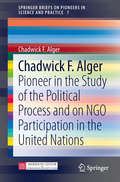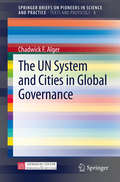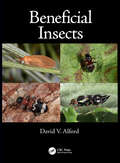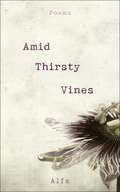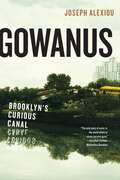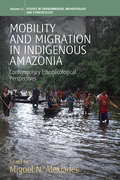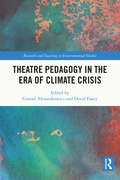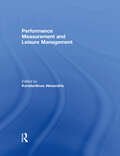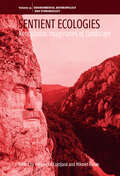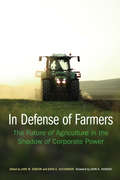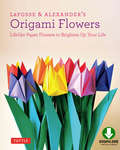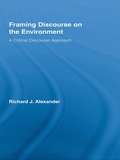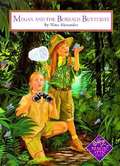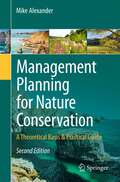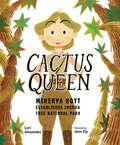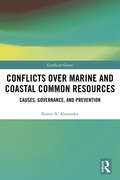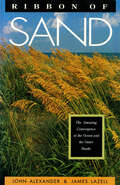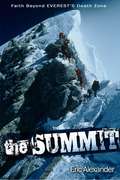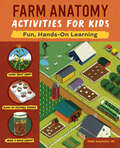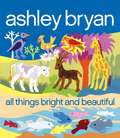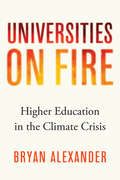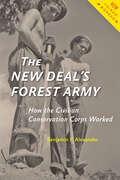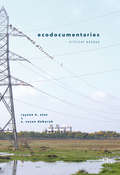- Table View
- List View
Chadwick F. Alger: Pioneer in the Study of the Political Process and on NGO Participation in the United Nations (SpringerBriefs on Pioneers in Science and Practice #7)
by Chadwick F AlgerThis volume honors the lifetime achievements of distinguished scholar Chadwick F. Alger on the occasion of his 90th birthday. Carolyn Stephenson presents Prof. Alger as a Pioneer in the Study of the Political Process and on NGO Participation in the United Nations. Part 1 offers an autobiographical note and a comprehensive bibliography of his academic publications. Part II includes three texts on "The Political Process in the UN," namely "The Researcher in the United Nations: Evolution of a Research Strategy," "Interaction in a Committee of the United Nations General Assembly" and "Interaction and Negotiation in a Committee of the UN GA." In Part III, which focuses on "Civil Society Organizations in the UN System (NGOs)," three chapters deal with "Evolving Roles of NGOs in Member State Decision-making in the UN System," "The Roles of NGOs in the UN System: From Article 71 to a People's Millennium Assembly" and "Strengthening relations between NGOs and the UN system: Towards a research agenda."
The UN System and Cities in Global Governance
by Chadwick F. AlgerThis is the second volume to commemorate the 90th birthday of the distinguished scholar Chadwick F. Alger to honor his lifetime achievement in international relations and as President of the International Studies Association (1978-1979). After a brief introduction by Chad F. Alger this volume presents six of his key texts on The UN System and Cities in Global Governance, focusing on "Cities as arenas for participatory learning in global citizenship"; "The Impact of Cities on International Systems"; "Perceiving, Analysing and Coping With the Local-Global Nexus"; "The World Relations of Cities: Closing the Gap Between Social Science Paradigms and Everyday Human Experience"; "Japanese Municipal International Exchange and Cooperation in the Asia-Pacific: Opportunities and Challenges" and on "Searching for Democratic Potential in Emerging Global Governance: What Are the Implications of Regional and Global Involvements of Local Governments?".
Beneficial Insects
by David AlfordInsects are key components of life on our planet, and their presence is essential for maintaining balanced terrestrial ecosystems. Without insects humans would struggle to survive, and on a world scale food production would be severely compromised. Many plants and animals depend directly or indirectly on insects for their very survival, and this is particularly so in the case of insectivorous birds and other such creatures. The beneficial role of insects is often overlooked or misunderstood, and in farming circles their very presence on crops is often seen to be unwelcome. In reality, however, many insects are genuinely beneficial, as in the case of parasitic and predacious species. The use of chemical pesticides to control crop pests is becoming more tightly regulated and environmentally undesirable, and low-input farming, in which natural enemies of pests are encouraged to survive or increase, is becoming far more prevalent. Accordingly, Integrated Pest Management (IPM) and Integrated Pest Management (ICM) strategies are increasingly being developed, advocated and adopted. <p><p>Features: <li>Highlights information on many groups of insects and mites that act as natural enemies or biological control agents of phytophagous insects and mites, including plant pests. <li>Profusely illustrated with high-quality colour photographs. <li>Focuses mainly on insects and mites as natural enemies of plant pests, including parasitic and predacious species that have been accidentally or deliberately introduced in classical biological control programmes. <li>Reviews the role of phytophagous European insects and mites in controlling or managing European plants that have become invasive weeds in other parts of the world, notably North America, Australia and New Zealand.
Amid Thirsty Vines: Poems
by AlfaThemes of self-discovery, tending the garden of the soul, and nurturing yourself into blossom, Amid Thirsty Vines by Instagram poetry star Alfa is the collection you need to feel the power of the beautiful flowers within you, and to find the love you deserve. This volume belongs in the collection of every modern poetry fan.
Gowanus: Brooklyn's Curious Canal
by Joseph AlexiouFor more than 150 years, Brooklyn's Gowanus Canal has been called a cesspool, an industrial dumping ground, and a blemish on the face of the populous borough--as well as one of the most important waterways in the history of New York harbor. Yet its true origins, man-made character, and importance to the city have been largely forgotten. Now, New York writer and guide Joseph Alexiou explores how the Gowanus creek--a naturally-occurring tidal estuary that served as a conduit for transport and industry during the colonial era--came to play an outsized role in the story of America's greatest city. From the earliest Dutch settlers of New Amsterdam, to nearby Revolutionary War skirmishes, or the opulence of the Gilded Age mansions that sprung up in its wake, historical changes to the Canal and the neighborhood that surround it have functioned as a microcosm of the story of Brooklyn's rapid nineteenth-century growth. Highlighting the biographies of nineteenth-century real estate moguls like Daniel Richards and Edwin C. Litchfield, Alexiou recalls the forgotten movers and shakers that laid the foundation of modern-day Brooklyn. As he details, the pollution, crime, and industry associated with the Gowanus stretch back far earlier than the twentieth century, and helped define the culture and unique character of this celebrated borough. The story of the Gowanus, like Brooklyn itself, is a tale of ambition and neglect, bursts of creative energy, and an inimitable character that has captured the imaginations of city-lovers around the world.
Mobility And Migration In Indigenous Amazonia
by Miguel N. AlexiadesContrary to ingrained academic and public assumptions, wherein indigenous lowland South American societies are viewed as the product of historical emplacement and spatial stasis, there is widespread evidence to suggest that migration and displacement have been the norm, and not the exception. This original and thought-provoking collection of case studies examines some of the ways in which migration, and the concomitant processes of ecological and social change, have shaped and continue to shape human-environment relations in Amazonia. Drawing on a wide range of historical time frames (from pre-conquest times to the present) and ethnographic contexts, different chapters examine the complex and important links between migration and the classification, management, and domestication of plants and landscapes, as well as the incorporation and transformation of environmental knowledge, practices, ideologies and identities.
Theatre Pedagogy in the Era of Climate Crisis (Research and Teaching in Environmental Studies)
by Conrad Alexandrowicz David FancyThis volume explores whether theatre pedagogy can and should be transformed in response to the global climate crisis. Conrad Alexandrowicz and David Fancy present an innovative re-imagining of the ways in which the art of theatre, and the pedagogical apparatus that feeds and supports it, might contribute to global efforts in climate protest and action. Comprised of contributions from a broad range of scholars and practitioners, the volume explores whether an adherence to aesthetic values can be preserved when art is instrumentalized as protest and considers theatre as a tool to be employed by the School Strike for Climate movement. Considering perspectives from areas including performance, directing, production, design, theory and history, this book will prompt vital discussions which could transform curricular design and implementation in the light of the climate crisis. Theatre Pedagogy in the Era of Climate Crisis will be of great interest to students, scholars and practitioners of climate change and theatre and performance studies.
Performance Measurement and Leisure Management
by Konstantinos AlexandrisThe issue of performance measurement in the leisure industry is increasingly important, from both theoretical (academic) and applied (practitioner) perspectives. Managers need accurate indications of how their organisations are performing, to inform their decisions. Policymakers need an evidence base for their decisions regarding public leisure services. Students and researchers in leisure management are increasingly turning their attention to the principles and evidence of performance measurement, as an aid to management decision-making.The chapters in this text each present a different case study of performance measurement. They cover a wide range of sectors in the leisure industry including public recreation centres, theme parks, play facilities, sport organisations, hospitality, and the Olympic Games. The evidence from these cases covers examples from three different continents and five different countries.All the chapters report empirical research and all the cases explore managerial implications. However, results are presented with clearly explained statistical analysis, which can be easily understood by a non-academic audience. The book will be useful for leisure management students, researchers and practitioners. The chapters provide both reviews of the relevant literature and propose new measurement models based on original data.This book was previously published as a special issue of Managing Leisure.
Sentient Ecologies: Xenophobic Imaginaries of Landscape (Environmental Anthropology and Ethnobiology #31)
by Alexandra Coțofană and Hikmet KuranEmploying methodological perspectives from the fields of political geography, environmental studies, anthropology, and their cognate disciplines, this volume explores alternative logics of sentient landscapes as racist, xenophobic, and right-wing. While the field of sentient landscapes has gained critical attention, the literature rarely seems to question the intentionality of sentient landscapes, which are often romanticized as pure, good, and just, and perceived as protectors of those who are powerless, indigenous, and colonized. The book takes a new stance on sentient landscapes with the intention of dispelling the denial of “coevalness” represented by their scholarly romanticization.
Australian Climate Law in Global Context
by Alexander Zahar Jacqueline Peel Lee Godden Alexander Zahar Jacqueline PeelAustralian Climate Law in Global Context is a comprehensive guide to current climate change law in Australia and internationally. It includes discussion of: emission trading schemes and carbon pricing laws, laws on renewable energy, biosequestration, carbon capture and storage and energy efficiency; the trading of emission offsets between developed and developing countries, the new international scheme for the protection of forests (REDD) and the transfer of green finance and technology from developed to developing states, the adaptation to climate change through legal frameworks. It assesses the international climate change regime from a legal perspective, focusing on Australia's unique circumstances and its domestic implementation of climate-related treaties. It considers how the challenge of climate change should be integrated into broader environmental law and management. It is a valuable resource for students in law and environmental science, for current and future legal practitioners and for policy-makers and those in the commercial sector.
In Defense of Farmers: The Future of Agriculture in the Shadow of Corporate Power (Our Sustainable Future)
by Sara Alexander Jane Gibson John K. HansenIndustrial agriculture is generally characterized as either the salvation of a growing, hungry, global population or as socially and environmentally irresponsible. Despite elements of truth in this polarization, it fails to focus on the particular vulnerabilities and potentials of industrial agriculture. Both representations obscure individual farmers, their families, their communities, and the risks they face from unpredictable local, national, and global conditions: fluctuating and often volatile production costs and crop prices; extreme weather exacerbated by climate change; complicated and changing farm policies; new production technologies and practices; water availability; inflation and debt; and rural community decline. Yet the future of industrial agriculture depends fundamentally on farmers’ decisions.In Defense of Farmers illuminates anew the critical role that farmers play in the future of agriculture and examines the social, economic, and environmental vulnerabilities of industrial agriculture, as well as its adaptations and evolution. Contextualizing the conversations about agriculture and rural societies within the disciplines of sociology, geography, economics, and anthropology, this volume addresses specific challenges farmers face in four countries: Bolivia, Brazil, Canada, and the United States. By concentrating on countries with the most sophisticated production technologies capable of producing the largest quantities of grains, soybeans, and animal proteins in the world, this volume focuses attention on the farmers whose labors, decision-making, and risk-taking throw into relief the implications and limitations of our global industrial food system. The case studies here acknowledge the agency of farmers and offer ways forward in the direction of sustainable agriculture.
LaFosse & Alexander's Origami Flowers
by Richard L. Alexander Michael G. LafosseLaFosse & Alexander's Origami Flowers Kit contains a full-color 96-page instruction book with clear diagrams and photos. The 2-1/2 hour downloadable instructional video is an added bonus, where the authors demonstrate how to fold each project in the kit. The flower projects range from simple to challenging. A variety of techniques are presented which origami makers can modify to create their own combinations. With these designs you can make greeting cards, gift boxes, bouquets, and stunning jewelry.This new collection of paper folding projects includes many innovative flower models such as:A striking Rose for Irene with interlocking Calyx ModuleThe gracefully-curled Plumeria and Star Flowers The bold Modular Six-Piece Day Lily BlossomAuthors LaFosse and Alexander together founded Origamido Studio, a learning center and design studio specializing in exquisite handmade origami paper. Their works has appeared in window displays and museum exhibitions around the world, and are made available to a wider audience for the first time.
Framing Discourse on the Environment: A Critical Discourse Approach (Routledge Critical Studies in Discourse)
by Richard AlexanderIn this study, Richard Alexander presents a series of original and empirically based case studies of the language and discourse involved in the discussion of environmental and ecological issues. Relying upon a variety of different text types and genres – including company websites, advertisements, press articles, speeches and lectures – Alexander interrogates how in the media, press, corporate and activist circles language is employed to argue for and propagate selected positions on the growing ecological crisis. For example, he asks: How are ecological and environmental concerns articulated in texts? What do we learn about ecological ‘problems’ through texts from differing sources? What language features accompany ecological discourse in differing contexts and registers? Attention is especially directed at where this discourse comes into contact with business, economic and political concerns.
Megan and the Borealis Butterfly (Magic Attic Club)
by Nina AlexanderWhen Megan finds herself transported to the Amazon rain forest, she can hardly believe her eyes! She meets a young girl named Dana who lives there with her parents. Dana tells Megan about the mysterious Borealis Butterfly and her quest to find it in the rain forest. Megan eagerly helps her search for the beautiful butterfly until she learns the real reason behind Dana's quest. Can Megan stop her before it's too late?
Management Planning for Nature Conservation: A Theoretical Basis & Practical Guide
by Mike AlexanderThe first edition of Mike Alexander's Management Planning for Nature Conservation, brought a new dimension to the modern literature on conservation management. This second edition, a significant enhancement of the original, deals with the development both, conceptual and practical, of adaptive management planning for nature conservation. It is about preparing management plans, and guides the reader through the entire process. Case-studies, including a conservation and access plan, demonstrate the planning process in action. This approach to planning can be applied to any place which is managed entirely, or in part, for wildlife. It can be applied to the management of species or habitats in any circumstance, regardless of site designation. The process is fully compatible with the Convention on Biological Diversity's 'ecosystem approach' to conservation management. Mike Alexander has long been at the forefront of developing management planning for conservation, with experience ranging from Uganda to Estonia, and from Costa Rica to Wales. He is the General Secretary of the Conservation Management System Consortium, a group of organisations with a common aim of raising standards and developing best practice in conservation management and planning. In 2012 Mike Alexander was elected a Fellow of the Society of Biology in recognition of his contribution to nature conservation and in particular management planning. This book has drawn on the experiences and expertise of the CMS consortium and other leaders in both conservation research and wildlife management from around the world. It is essential reading for professional conservation managers and any student studying management planning for conservation within a range of degree and postgraduate courses.
Cactus Queen: Minerva Hoyt Establishes Joshua Tree National Park
by Lori AlexanderHow did the Joshua Tree National Park in California come to be? Meet Minerva Hamilton Hoyt, an artist, activist, and environmentalist, whose determination saved the desert and helped to create the park, in this STEAM picture book.Long before she became known as the Cactus Queen, Minerva Hamilton Hoyt found solace in the unexpected beauty of the Mojave Desert in California. She loved the jackrabbits and coyotes, the prickly cacti, and especially the weird, spiky Joshua trees.However, in the 1920s, hardly anyone else felt the same way. The desert was being thoughtlessly destroyed by anyone and everyone. Minerva knew she needed to bring attention to the problem. With the help of her gardening club, taxidermists, and friends, she took the desert east and put its plants and animals on display. The displays were a hit, but Minerva needed to do much more: she wanted to have the desert recognized as a national park. Although she met with President Franklin D. Roosevelt and won him over, Minerva still had to persuade politicians, scientists, teachers, and others to support her cause. And, it worked! Minerva&’s efforts led to what came to be known as Joshua Tree National Park in California, and saved hundreds of thousands of plants and animals. Now, the millions of people who visit each year have learned to love the desert, just as Minerva did.
Conflicts over Marine and Coastal Common Resources: Causes, Governance and Prevention (Earthscan Oceans)
by Karen A. AlexanderThis book explores the types of conflicts that occur over marine and coastal resources, the underlying causes, and attempts to prevent them. Despite the emergence of various marine and coastal governance approaches to address the effects of human activities within the marine environment, conflict continues. In this book, the author outlines the reasons conflicts can, and do, arise in the marine and coastal environment. Drawing on case studies from both the northern and southern hemispheres, the book takes a broad view of how we interact with our environment, of how and why conflict is perpetuated as a political and cultural phenomenon, and how this varies or remains constant across space and place. The case studies explore not only the underlying perceptions and needs of those involved in marine and coastal conflict and the types of conflicts that arise in oceanic and coastal areas, but also the underpinning reasons for these conflicts. Marine and coastal resource conflicts have the potential to derail conservation efforts and blue growth policies, as well as the United Nations Sustainable Development Goals. Thus, it is imperative we understand the drivers and exacerbating factors of marine and coastal conflict. Arguing that there is an urgent need for renewed thinking and focus on conflict prevention, the author develops a theory of marine and coastal conflict which allows us to understand those factors and the means to help prevent such conflicts arising in the first place. This book will be of interest to students and researchers of coastal and marine science and environmental management as well as those working in the field of marine resource management, including coastal zone managers and fisheries managers.
Ribbon of Sand: The Amazing Convergence of the Ocean and the Outer Banks (Chapel Hill Bks.)
by John Alexander James LazellWind, currents, tides, and sand. Kingsnakes and rice rats. The disappearance of the Lost Colony, the raids of the pirate Blackbeard, and the Wright brothers' first attempts at flight. The Outer Banks is a place like no other.
The Summit
by Eric AlexanderIt's one of the greatest challenges one can face on Earth: an ascent to the top of the world on the slopes of Mount Everest. Eric Alexander experienced grace and a faith-empowering journey he will never forget as part of a record-setting team in May 2001, scaling the heights of Everest with his friend, blind climber Erik Weihenmayer. Experience some of the most dangerous locations in the world, including abject terror on Ama Dablam, a blind ski descent of Russia's Mount Elbrus, and up Kilimanjaro in Africa with four blind teens Gain wisdom in the application of trust, courage, innovation, teamwork, leadership, and integrity to overcome your own Everests. Discover practical faith lessons learned on the highest peaks of six continents. Here is the powerful story of Eric Alexander and his unique life journey of guiding people with disabilities as they overcome the most perilous places of the world. Follow in their footsteps, and learn about faith, trust, prayer, depending on God, as well as the perseverance needed in your own life. Be inspired and motivated by Eric's insight, not simply to survive but to thrive every day in God's grace.
Farm Anatomy Activities for Kids: Fun, Hands-On Learning (Anatomy Activities for Kids)
by Dawn AlexanderHelp kids ages 8 to 12 discover how awesome and fun farms can be No matter where you live, you can learn all about the amazing things that happen on farms. Farm Anatomy Activities for Kids combines the joy of hands-on experiments and activities with easy-to-understand lessons that teach you all about farm life. This farm anatomy activity book helps you think more like a farmer and understand how nature, crops, and animals shape the way we live. You'll learn about all the different parts of a farm, the plants and animals you might find there, and how farms create the food you eat and the material for the clothes you wear. Farm Anatomy Activities for Kids includes: Educational lessons—Learn about the various parts of a farm, how they raise plants and animals, and the ways farms connect to your daily life no matter where you live. Ways to play—Try out cool experiments like growing crops without soil or making a mason bee house. Journal prompts—Reflect on what you've learned about farm anatomy with the thoughtful writing prompts paired with each activity. Take kids on an educational journey down to the farm without ever leaving home.
All Things Bright and Beautiful
by Cecil F. Alexander Ashley BryanAll things bright and beautiful; all creatures great and small; all things wise and wonderful, the incredible Ashley Bryan illustrates them all!
Universities on Fire: Higher Education in the Climate Crisis
by Bryan AlexanderScientists agree that we are on the precipice of a global climate crisis. How will it transform colleges and universities?In 2019, intense fires in the San Francisco Bay Area closed universities and drove afflicted people to shelter at other campuses. At the same time, extraordinary fires ravaged eastern Australia. Several universities responded by promising material and research support to damaged businesses while also hosting refugees and emergency response teams in student residence halls. This was an echo of the devastation wreaked by Hurricane Katrina on Tulane University in 2005.In Universities on Fire, futurist Bryan Alexander explores higher education during an age of unfolding climate crisis. Powered by real-world examples and the latest research, Alexander assesses practical responses and strategies by surveying contemporary programs and academic climate research from around the world. He establishes a model of how academic institutions may respond and offers practical pathways forward for higher education. How will the two main purposes of education—teaching and research—change as the world heats up? Alexander positions colleges and universities in the broader social world, from town-gown relationships to connections between how campuses and civilization as a whole respond to this epochal threat.Current studies of climate change trace the likely implications across a range of domains, from agriculture to policy, urban design, technology, culture, and human psychology. However, few books have predicted or studied the effects of the climate crisis on colleges and universities. By connecting climate research to a deep, futures-informed analysis of academia, Universities on Fire explores how climate change will fundamentally reshape higher education.
The New Deal's Forest Army: How the Civilian Conservation Corps Worked (How Things Worked)
by Benjamin F. AlexanderHow the Civilian Conservation Corps constructed, rejuvenated, and protected American forests and parks at the height of the Great Depression.Propelled by the unprecedented poverty of the Great Depression, President Franklin D. Roosevelt established an array of massive public works programs designed to provide direct relief to America’s poor and unemployed. The New Deal’s most tangible legacy may be the Civilian Conservation Corps’s network of parks, national forests, scenic roadways, and picnic shelters that still mark the country’s landscape. CCC enrollees, most of them unmarried young men, lived in camps run by the Army and worked hard for wages (most of which they had to send home to their families) to preserve America’s natural treasures. In The New Deal’s Forest Army, Benjamin F. Alexander chronicles how the corps came about, the process applicants went through to get in, and what jobs they actually did. He also explains how the camps and the work sites were run, how enrollees spent their leisure time, and how World War II brought the CCC to its end. Connecting the story of the CCC with the Roosevelt administration’s larger initiatives, Alexander describes how FDR’s policies constituted a mixed blessing for African Americans who, even while singled out for harsh treatment, benefited enough from the New Deal to become an increasingly strong part of the electorate behind the Democratic Party. The CCC was the only large-scale employment program whose existence FDR foreshadowed in speeches during the 1932 campaign—and the dearest to his heart throughout the decade that it lasted. Alexander reveals how the work itself left a lasting imprint on the country’s terrain as the enrollees planted trees, fought forest fires, landscaped public parks, restored historic battlegrounds, and constructed dams and terraces to prevent floods. A uniquely detailed exploration of life in the CCC, The New Deal’s Forest Army compellingly demonstrates how one New Deal program changed America and gave birth to both contemporary forestry and the modern environmental movement.
Ecodocumentaries
by Rayson K. Alex S. Susan DeborahThis book features ten critical essays on ecodocumentaries written by eminent scholars from India, USA, Ireland, Finland and Turkey in the area of ecocinema studies. Situating social documentaries with explicit ecological form and content, the volume takes relational positions on political, cultural and conservational aspects of natures and cultures in various cultural contexts. Documentaries themed around issues such as electronic waste, animal rights, land ethics, pollution of river, land grabbing, development and exotic plants are some of the topics ecocritiqued in this volume.
